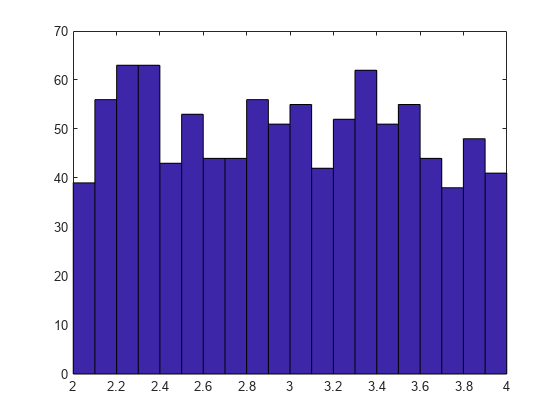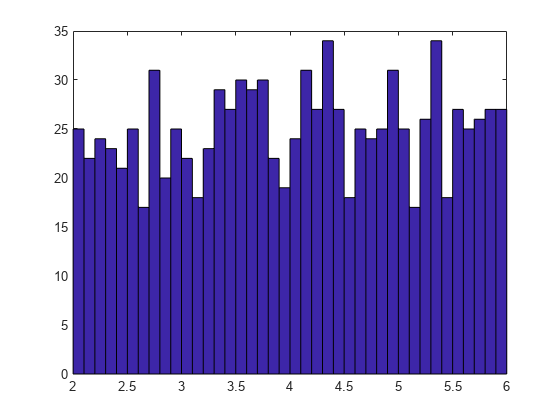Uncertain Real Parameters
An uncertain real parameter, ureal, is the Control Design Block that represents a real number whose
value is uncertain.
Properties of Uncertain Real Parameters
Uncertain real parameters have a name (the Name property), and a
nominal value (the NominalValue property). Several other properties
(PlusMinus, Range, Percentage)
describe the uncertainty in parameter values.
All properties of a ureal can be accessed through
get and set. The properties are:
|
Properties |
Meaning |
Class |
|---|---|---|
|
|
Internal name |
|
|
|
Nominal value of element |
|
|
|
Signifies which description (from |
|
|
|
Additive variation |
|
|
|
Numerical range |
|
|
|
Additive variation (% of absolute value of nominal) |
|
|
|
|
|
The properties Range, Percentage and
PlusMinus are all automatically synchronized. If the nominal value is
0, then the Mode cannot be Percentage. The
Mode property controls what aspect of the uncertainty remains unchanged
when NominalValue is changed. Assigning to any of
Range/Percentage/PlusMinus
changes the value, but does not change the mode.
The AutoSimplify property controls how expressions involving the real
parameter are simplified. Its default value is 'basic', which means
elementary methods of simplification are applied as operations are completed. Other values
for AutoSimplify are 'off' (no simplification
performed) and 'full' (model-reduction-like techniques are applied). See
Simplifying Representation of Uncertain Objects to learn
more about the AutoSimplify property and the command
simplify.
If no property/value pairs are specified, default values are used. The default
Mode is PlusMinus, and the default value of
PlusMinus is [-1 1]. Some examples are shown below.
In many cases, the full property name is not specified, taking advantage of the
case-insensitive, partial name property matching.
Create Uncertain Real Parameters
This example shows how to create uncertain real parameters, modify properties such as range of uncertainty, and sample uncertain parameters.
Create an uncertain real parameter, nominal value 3, with default values for all unspecified properties (including plus/minus variability of 1).
a = ureal('a',3)Uncertain real parameter "a" with nominal value 3 and variability [-1,1]. Block Properties
View the properties and their values, and note that the Range and Percentage descriptions of variability are automatically maintained.
get(a)
NominalValue: 3
Mode: 'PlusMinus'
Range: [2 4]
PlusMinus: [-1 1]
Percentage: [-33.3333 33.3333]
AutoSimplify: 'basic'
Name: 'a'
Create an uncertain real parameter, nominal value 2, with 20% variability. Again, view the properties, and note that the Range and PlusMinus descriptions of variability are automatically maintained.
b = ureal('b',2,'Percentage',20)
Uncertain real parameter "b" with nominal value 2 and variability [-20,20]%. Block Properties
get(b)
NominalValue: 2
Mode: 'Percentage'
Range: [1.6000 2.4000]
PlusMinus: [-0.4000 0.4000]
Percentage: [-20 20]
AutoSimplify: 'basic'
Name: 'b'
Change the range of the parameter. All descriptions of variability are automatically updated, while the nominal value remains fixed. Although the change in variability was accomplished by specifying the Range, the Mode is unaffected, and remains Percentage.
b.Range = [1.9 2.3]; get(b)
NominalValue: 2
Mode: 'Percentage'
Range: [1.9000 2.3000]
PlusMinus: [-0.1000 0.3000]
Percentage: [-5.0000 15.0000]
AutoSimplify: 'basic'
Name: 'b'
As mentioned, the Mode property signifies what aspect of the uncertainty remains unchanged when NominalValue is modified. Hence, if a real parameter is in Percentage mode, then the Range and PlusMinus properties are determined from the Percentage property and NominalValue. Changing NominalValue preserves the Percentage property, and automatically updates the Range and PlusMinus properties.
b.NominalValue = 2.2; get(b)
NominalValue: 2.2000
Mode: 'Percentage'
Range: [2.0900 2.5300]
PlusMinus: [-0.1100 0.3300]
Percentage: [-5.0000 15.0000]
AutoSimplify: 'basic'
Name: 'b'
Create an uncertain parameter with an asymmetric variation about its nominal value. Examine the properties to confirm the asymmetric range.
c = ureal('c',-5,'Percentage',[-20 30]); get(c)
NominalValue: -5
Mode: 'Percentage'
Range: [-6 -3.5000]
PlusMinus: [-1 1.5000]
Percentage: [-20 30]
AutoSimplify: 'basic'
Name: 'c'
Create an uncertain parameter, specifying variability with Percentage, but force the Mode to be Range.
d = ureal('d',-1,'Mode','Range','Percentage',[-40 60]); get(d)
NominalValue: -1
Mode: 'Range'
Range: [-1.4000 -0.4000]
PlusMinus: [-0.4000 0.6000]
Percentage: [-40 60]
AutoSimplify: 'basic'
Name: 'd'
Finally, create an uncertain real parameter, and set the AutoSimplify property to 'full'.
e = ureal('e',10,'PlusMinus',[-23],'Mode','Percentage','AutoSimplify','Full')
Uncertain real parameter "e" with nominal value 10 and variability [-230,230]%. Block Properties
get(e)
NominalValue: 10
Mode: 'Percentage'
Range: [-13 33]
PlusMinus: [-23 23]
Percentage: [-230 230]
AutoSimplify: 'full'
Name: 'e'
Specifying conflicting values for Range/Percentage/PlusMinus when creating a ureal element does not result in an error. In this case, the last specified property is used. This last occurrence also determines the Mode, unless Mode is explicitly specified, in which case that is used, regardless of the property/value pairs ordering.
f = ureal('f',3,'PlusMinus',[-2 1],'Percentage',40)
Uncertain real parameter "f" with nominal value 3 and variability [-40,40]%. Block Properties
g = ureal('g',2,'PlusMinus',[-2 1],'Mode','Range','Percentage',40)
Uncertain real parameter "g" with nominal value 2 and range [1.2,2.8]. Block Properties
g.Mode
ans = 'Range'
Create an uncertain real parameter, use usample to generate 1000 instances (resulting in a 1-by-1-by-1000 array), reshape the array, and plot a histogram, with 20 bins (within the range of 2 to 4).
h = ureal('h',3);
hsample = usample(h,1000);
hist(reshape(hsample,[1000 1]),20);
Make the range nonsymmetric about the nominal value, and repeat the sampling, and histogram plot (with 40 bins over the range of 2-to-6)
h.Range = [2 6]; hsample = usample(h,1000); hist(reshape(hsample,[1000 1]),40);

The distribution is still uniform. The distribution used by usample is uniform in the actual value of the uncertain real parameter. However, highly skewed ranges can lead to poor numeric conditioning and poor results. Therefore, for meaningful results, avoid highly skewed ranges where the nominal value is orders of magnitude closer to one end of the range than to the other.
There is no notion of an empty ureal (or any other uncertain element, for that matter). ureal, by itself, creates an element named 'UNNAMED', with default property values.